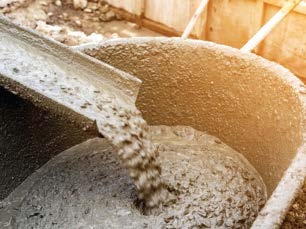- Lost workdays in the masonry fields are 2.5 times greater than for other construction activities.
- Concrete workers report four times more lost workdays for skin problems than other construction workers.
Skin burns are just one of the common hazards associated with concrete. Dry cement contains calcium oxide that, when exposed to water, creates calcium hydroxide with a pH of 12-14. Contact with corrosive cement over periods of time make it likely that a burn will happen. Be sure to wear eye protection – full-cover goggles or safety glasses with side shields to protect against blowing dust (the moisture in the eyes will mix with the dust, making it caustic), splattering concrete and other foreign objects.
Once the eyes or the skin areas have been directly exposed to wet concrete, immediate steps should be followed to slow the burning process:
- Remove any contaminated clothing, being careful not to touch unexposed areas. Promptly rinse clothes in clean water.
- Gently brush any dry chemicals off the skin and flush the affected area with clean running water for at least 20 minutes. To help neutralize the alkalinity, add vinegar or a buffer to the water (a fact proven by a study by the American Society of Plastic Surgeons). Vinegar and similar weak acids help neutralize the alkaline substance 15 minutes faster than using water alone, the study found.
- If the eyes are involved, rinse eyes with clean water for 20 minutes.
- Seek professional medical attention immediately if the burn is more than 3 inches across, very deep, or covers the hands, feet, face, groin, or a major joint. Delaying treatment can mean the difference between a mild burn and a severe burn.
- Provide the medical personnel with a product Safety Data Sheet, which explains the skin hazards of concrete exposure and first aid procedures.
Remove all jewelry, watches, belts, etc., because the wet concrete can become trapped against the skin.
If your clothing becomes saturated, change it. Wet clothing will transmit alkalinity via a “hygroscopic” process, in which the fabric molecules actually become charged and will intensify the skin burn. Workers need to be especially careful when removing gloves, boots, and other work clothes so as not to contaminate other skin areas.


 RSS Feed
RSS Feed
